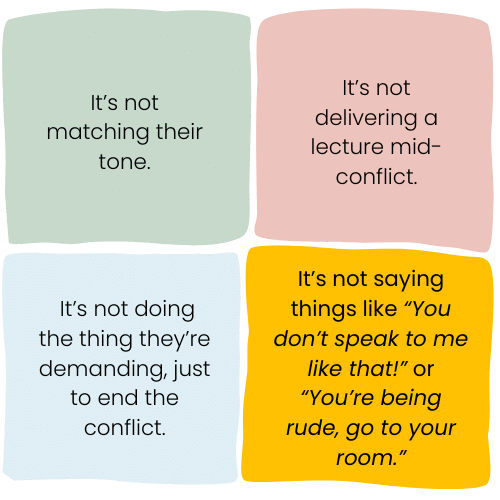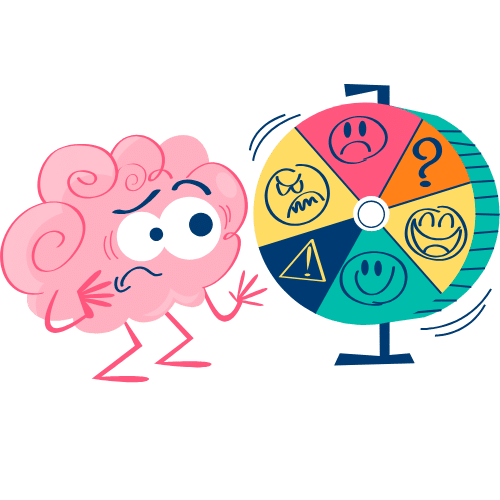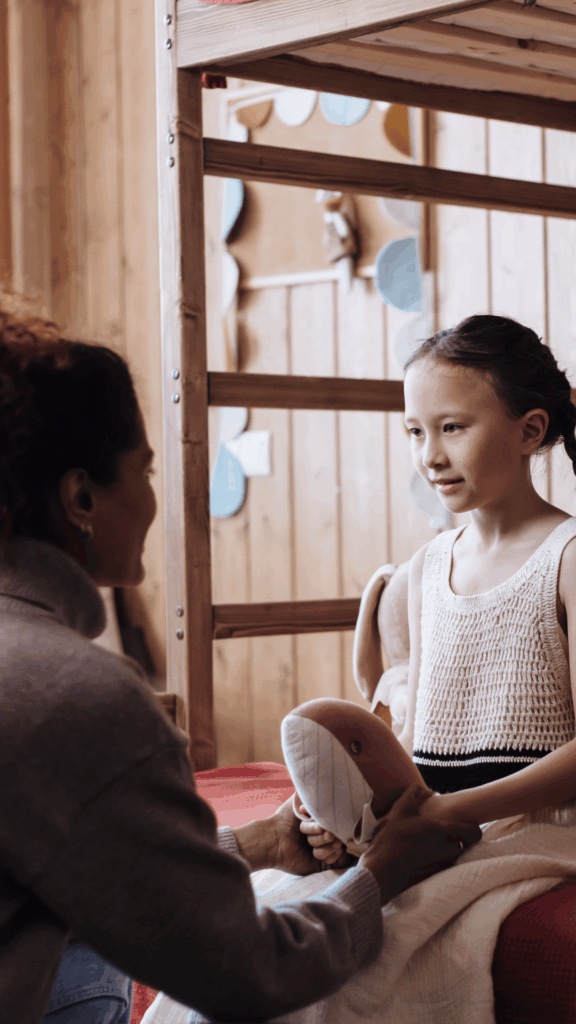
As a parent coach, one of the most common challenges I hear from parents is how to stop power struggles when their child talks back, especially when it pushes their buttons. Backtalk often triggers power struggles, making it hard to respond without escalating things further.
What if I told you there’s a simple, science-backed way to defuse the tension, reconnect, and help your child develop emotional regulation and accountability, without shame or punishment?
The “Try Again” method has been a game changer in our home and in the homes of many parents I support.
When backtalk pushes your buttons: A personal story
As our children grow, so do their brains and their voices. They start experimenting with tone, testing limits, and sometimes saying things that sting. It’s developmentally normal… but it doesn’t always feel great.
If you’ve ever thought: “Why are they speaking to me like that? I’ve never spoken to them this way!” you’re definitely not alone. That’s exactly where I was.
Let me tell you a quick story that made this lesson real for me:
One evening, after a long, playful afternoon, my daughter had a mountain of toys to clean up. (For clarity, we had been working a lot towards collaborative clean-up, and as she grows older, clean-up starts to become more autonomous while I still offer a hand when needed.) She looked around, overwhelmed. And then she looked at me and said with an ordering voice:
👉 “You clean all this up because you played too.”
My first impulse sounded like this:
“Excuse me? I don’t like the way you’re talking to me. You’re being rude. I only played for a while with you out of this entire bazaar of toys, and now you want to order me around? If you didn’t want so much to clean, maybe you should’ve put each toy away after playing instead of saying you’d do it later. I would have helped, but now that you’ve demanded it like this I won’t!”
Oof. That reaction was loud in my head. I took a deep breath and remembered: “Although it feels like that, this is not personal.”
This was her overwhelm talking. Her frustration at realizing how much she had left for later and how tired she now felt. My job is not to fix her feelings. My job is to help her reframe and own her words and actions without shaming, while holding firm limits with kindness.
She wasn’t trying to hurt me. She was dysregulated and reaching for someone safe to toss her hard feelings to. And because I was the safe one, she handed them to me. And in that moment, I didn’t take the hook.

What does “Not taking the hook” look like?
💡 Let’s talk about that idea of “not taking the hook.”
When our children speak sharply, throw out a blaming comment, or use a provocative tone, it’s easy to snap back. But that moment, “the hook” is where we get to choose differently.
What does not taking the hook look like in practice?

Responding with defensiveness (“Don’t speak to me like that!” or “After all I do for you…”) often escalates power struggles. But when we stay neutral and grounded, we model emotional regulation—and that’s how children learn it.
Introducing the “Try again” method
Instead, we need to pause, to keep breathing and be aware of ourselves and stay grounded in the present. And sometimes, it’s simply saying:
🙋♀️ “Try again.”
The magic in “Try again” is that it creates a natural pause, not a punishment. It invites your child’s higher brain to come back online, allowing them to practice respectful communication in a moment when their nervous system is just beginning to regulate again. This kind of co-regulated do-over (what experts call co-regulation) is both kind and developmentally aligned.
The phrase “Try again” isn’t just a gentle invitation, it also sets a clear, firm, and kind limit. Many parents struggle with boundaries, worried about being too strict or too lenient. Saying “Try again” communicates that disrespectful or hurtful words aren’t acceptable, while still offering your child the chance to correct themselves without shame or punishment. It’s a healthy form of respectful discipline: firm, clear, and rooted in connection. It’s a healthy way to protect the relationship and teach respect, showing that limits can be kind and constructive, not just restrictive.

How to use “Try again” when it’s new to your child
💬 But what if this is new to your child?
If they’ve never heard “try again” before, or if they’re too upset to access it, you can offer a bit more guidance at first:
“I can see you’re trying to tell me something, and I really want to hear you. When you’re ready to use your regular voice so we can talk respectfully, you can try again.”
Say it once. Calmly. Kindly. Then pause. Let the invitation hang. Give them the dignity of choosing to meet you there.
Why “Try again” works: A brain-based insight
When our children lash out, it’s often because they’re overwhelmed. Their brain is in fight-or-flight mode, and the thinking part (the prefrontal cortex) isn’t fully online. That’s why harsh discipline or lectures don’t land: the brain literally can’t process them in that moment.
What “Try again” does is offer a gentle, yet sturdy, cue to re-engage. It signals to your child, “I see you. You’re safe. Let’s try that another way. No pressure, we can wait until you are ready to try again.” This simple phrase invites the thinking brain back online. It offers a second chance with limits, respect, guidance, and without shame.

It’s not about manners — It’s about repair and connection
It’s not about being polite. It’s about being real. There is no emergency here, no quick fixes.
This is what gentle parenting and conscious parenting look like in action: boundaries with warmth, correction with connection. Some people hear “Try again” and think it’s about manners or forcing a child to perform. It’s not.
It’s about showing children that repair is possible. That relationships can be messy and forgiving. That they can say the wrong thing, feel big feelings and still be loved.
The magic isn’t in the words. It’s in the energy behind them.
So when I say, “Try again,” it’s not with judgment. It’s with warmth. It is an invitation and a belief in her capacity to do better. You help your child develop emotional regulation and accountability by radiating trust that they will achieve it.
Why does this work?
Because it cultivates connection, respect, and collaboration. Because staying quiet, but present, creates space.
And in that space, children begin to own their words and behavior because we take away the pressure and the urgency. We radiate trust, faith, limits, kindness and sturdiness.
They realize:
- You’re not punishing or shaming them.
- You’re not taking the bait.
- You trust them to come back into connection.
This isn’t passive. It’s powerful. And hard! Because in that moment, your whole body may want to correct or control. But instead, you’re offering something different: an invitation to regulate and reconnect. It is your go-to tool instead of feeling helpless and feeling that you need to resort to time-outs, threats, or ignoring just because you feel that there is nothing else left for you to try.

Developmental note: Why young children struggle with regulation.
🧠Especially during the ages where emotional regulation is still forming, often between ages 4 and 8, children are only beginning to form the neural connections that support flexible thinking, working memory, and self-regulation. Their prefrontal cortex (the part of the brain responsible for planning and regulating emotions) is still developing. So when they’re overwhelmed or tired, what comes out can sound harsh, even bossy. Understanding this doesn’t mean you let everything slide. It means you respond in a way that actually helps them grow.
What to do when your child keeps pushing boundaries
But what if they keep pushing?
Stay kind and sturdy. You might say:
“I’m here to listen to whatever you want to share, when you’re ready to talk to me respectfully.”
Then go back to what you were doing. Calm. Unmoved. Kind.
Why?
Because what your child needs isn’t your anger, it’s your leadership. Your calm presence, your clarity, and your belief that they can do better.

Encouraging and guiding your child when they try again:
👣 And when they do try again? Even if it’s wobbly, maybe the voice is still a bit sharp, but you can see the effort—acknowledge it.
- “I see you’re trying, and I really appreciate that.”
- “That’s your regular voice, I can hear you now. I’m here.”
Guide them gently:
“Let’s take a second, can you tell me what you were really needing back then? Try starting with ‘I was feeling…’ and ‘I was needing…’”
When they share, don’t analyze. Just say:
“That makes total sense to me. Thank you for helping me understand.”
Then move into collaborative problem-solving:
“What could we do differently next time to make this easier?”
Let them take the lead. Step in just enough to keep them going if they get stuck.That’s where learning happens. That’s where connection is built.
Real-life example: My daughter's reflection
For my daughter, that looked like:
“I was feeling overwhelmed and I had regretted that I hadn’t taken the time to put things back right after finishing playing with them. I saw them all and I feared that it would take a lot of time and then we wouldn’t have time to read a book before sleep. I needed some help and I didn’t know how to say it. I was afraid that you would say no and I thought that by saying it like that you would help me.”
This process isn’t about obedience. It’s about mutual respect. Respect is something we learn by living it, not by being yelled at or shamed/punished when we mess up.
It’s about modeling the emotional regulation we hope our children will one day offer to themselves and to others.

Trust the process and repair the connection
So next time your child’s words sting, take a breath. Say “try again”, and trust that space, silence, and safety can do more than any lecture ever will.
They’ll surprise you.
They’ll come back.
They’ll try again.
And that moment?
That’s where connection grows.

A gentle note for parents: Repair is always possible!
If you’ve snapped in the past, or matched your child’s sharp tone with your own, you’re not alone. That happens to the best of us! Repair is always possible.
You can always say:
“Hey, I didn’t like how I responded earlier. Can we try again?”
That phrase isn’t just for kids—it’s for all of us. And it’s never too late to use it.
If this article resonated with you and you’d love hands-on support applying the “Try Again” method in your own family, I’d love to support you. We could work on how to integrate the “Try Again” method in your family. The trickiest part is regulating yourself first—because without that, “try again” can come out sounding like just another command. And you won’t get the beautiful connection, trust, and cooperation it’s meant to build.
You can book your time by getting the free discovery call now.